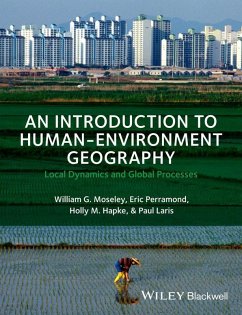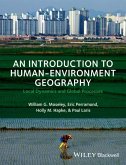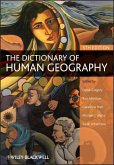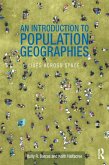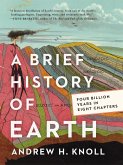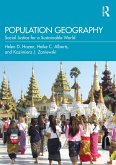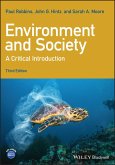This introductory level text explores various theoretical approaches to human-environment geography, demonstrating how local dynamics and global processes influence how we interact with our environments.
- Introduces students to fundamental concepts in environmental geography and science
- Explores the core theoretical traditions within the field, along with major thematic issues such as population, food and agriculture, and water resources
- Offers an engaging and unique view of the spatial relationships between humans and their environment across geographical locations around the world
- Includes a variety of real-world policy questions and emphasizes geography's strong tradition of field work by featuring prominent nature-society geographers in guest field notes
Dieser Download kann aus rechtlichen Gründen nur mit Rechnungsadresse in D ausgeliefert werden.
"This is a great textbook, which introduces students tofundamental concepts in environmental geography and science. . . Itis warmly recommended to bachelor students in human ecology and tomaster degree students in environmental sciences andgeography." (International Journal Environment & Pollution, 1 October 2014)
"Contributes a much-needed geographic perspective to theburgeoning, interdiscplinary field of environmental studies...Wheremany environmental science texts operate from the assumption thatnature is a place without humans, this book demonstrates that evenforests and soils have a human history...Wellsuited to beginningundergraduates. Chapters contain clear learning objectives,summaries, and end-of-chapter questions. Scientific and socialscientific concepts are explained with a minimum of technicalterminology. Geography students will find it provides a solidfoundation for future studies in human-environmentinteractions...fills an important niche by adding a distinctlygeographical voice to the environmental studiesconversation." (Journal of Geography, September2014)
"As a primer on the sort of ideas that should beconsidered, this is a useful addition." (Ecogeog, 1 May 2014)
"Summing Up: Recommended. Lower-division undergraduate andgraduate readers." (Choice, 1 May 2014)
"A first of its kind and in my opinion, a complete winner.An introductory textbook that presents in an engaging andaccessible style, geography's unique approach to environmentalissues. Highly recommended."
--Judith Carney, UCLA
"This is a refreshing and engaging book which focuses onthe real core of geographical study - understanding therelationships between people and environment. The structure of thebook is innovative for an introductory text, and students willparticularly appreciate the many links which are drawn betweentheory and practice, and which are illustrated very effectivelythrough an impressive range of case studies. The authors should becommended on producing a book which really does break new ground inits objectives, structure and content."
--Tony Binns, University of Otago, New Zealand
"A long-overdue textbook that is at once comprehensivewhile remaining accessible. The authors have done an impressive jobat synthesizing an enormous amount of material and perspectiveswith a clarity that is refreshing and engaging. It willprovide students with a guide to this dynamic sub-field anddemonstrate how critical inquiry using this approach will enablethem to address important and complex issues in the contemporaryworld. Including clear chapter objectives, critical questions,tables, and 'icebreakers', the book provides necessarybackground materials while also demonstrating how research is livedexperience by those conducting it."
--Antoinette WinklerPrins, Johns HopkinsUniversity
"Contributes a much-needed geographic perspective to theburgeoning, interdiscplinary field of environmental studies...Wheremany environmental science texts operate from the assumption thatnature is a place without humans, this book demonstrates that evenforests and soils have a human history...Wellsuited to beginningundergraduates. Chapters contain clear learning objectives,summaries, and end-of-chapter questions. Scientific and socialscientific concepts are explained with a minimum of technicalterminology. Geography students will find it provides a solidfoundation for future studies in human-environmentinteractions...fills an important niche by adding a distinctlygeographical voice to the environmental studiesconversation." (Journal of Geography, September2014)
"As a primer on the sort of ideas that should beconsidered, this is a useful addition." (Ecogeog, 1 May 2014)
"Summing Up: Recommended. Lower-division undergraduate andgraduate readers." (Choice, 1 May 2014)
"A first of its kind and in my opinion, a complete winner.An introductory textbook that presents in an engaging andaccessible style, geography's unique approach to environmentalissues. Highly recommended."
--Judith Carney, UCLA
"This is a refreshing and engaging book which focuses onthe real core of geographical study - understanding therelationships between people and environment. The structure of thebook is innovative for an introductory text, and students willparticularly appreciate the many links which are drawn betweentheory and practice, and which are illustrated very effectivelythrough an impressive range of case studies. The authors should becommended on producing a book which really does break new ground inits objectives, structure and content."
--Tony Binns, University of Otago, New Zealand
"A long-overdue textbook that is at once comprehensivewhile remaining accessible. The authors have done an impressive jobat synthesizing an enormous amount of material and perspectiveswith a clarity that is refreshing and engaging. It willprovide students with a guide to this dynamic sub-field anddemonstrate how critical inquiry using this approach will enablethem to address important and complex issues in the contemporaryworld. Including clear chapter objectives, critical questions,tables, and 'icebreakers', the book provides necessarybackground materials while also demonstrating how research is livedexperience by those conducting it."
--Antoinette WinklerPrins, Johns HopkinsUniversity

